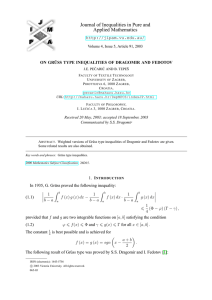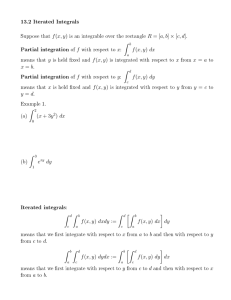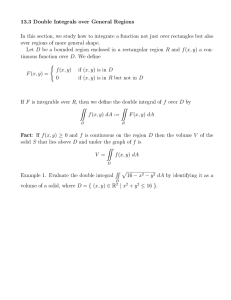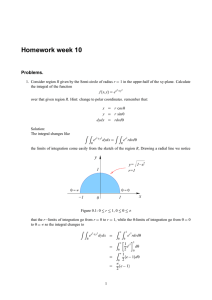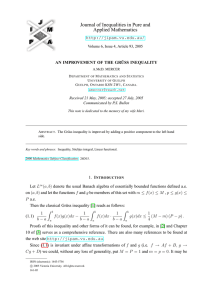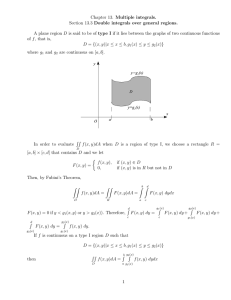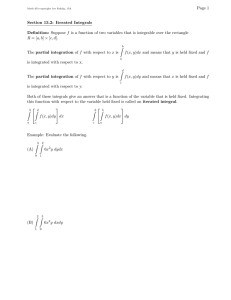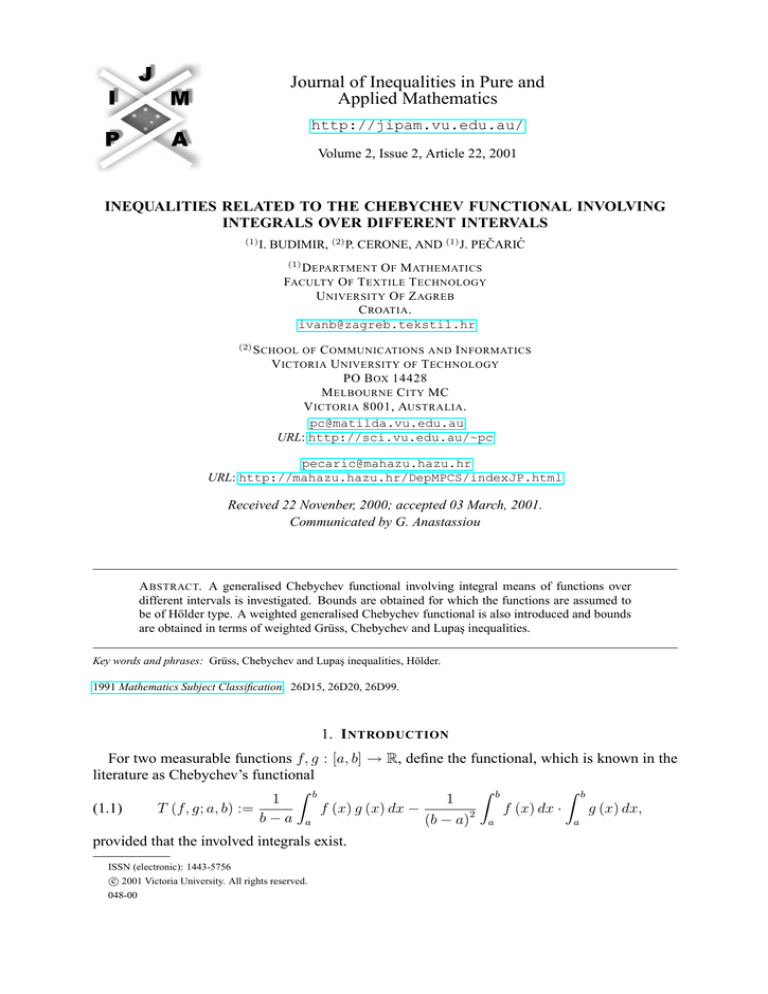
Journal of Inequalities in Pure and
Applied Mathematics
http://jipam.vu.edu.au/
Volume 2, Issue 2, Article 22, 2001
INEQUALITIES RELATED TO THE CHEBYCHEV FUNCTIONAL INVOLVING
INTEGRALS OVER DIFFERENT INTERVALS
(1)
I. BUDIMIR, (2) P. CERONE, AND (1) J. PEČARIĆ
(1)
D EPARTMENT O F M ATHEMATICS
FACULTY O F T EXTILE T ECHNOLOGY
U NIVERSITY O F Z AGREB
C ROATIA .
ivanb@zagreb.tekstil.hr
(2)
S CHOOL OF C OMMUNICATIONS AND I NFORMATICS
V ICTORIA U NIVERSITY OF T ECHNOLOGY
PO B OX 14428
M ELBOURNE C ITY MC
V ICTORIA 8001, AUSTRALIA .
pc@matilda.vu.edu.au
URL: http://sci.vu.edu.au/~pc
pecaric@mahazu.hazu.hr
URL: http://mahazu.hazu.hr/DepMPCS/indexJP.html
Received 22 Novenber, 2000; accepted 03 March, 2001.
Communicated by G. Anastassiou
A BSTRACT. A generalised Chebychev functional involving integral means of functions over
different intervals is investigated. Bounds are obtained for which the functions are assumed to
be of Hölder type. A weighted generalised Chebychev functional is also introduced and bounds
are obtained in terms of weighted Grüss, Chebychev and Lupaş inequalities.
Key words and phrases: Grüss, Chebychev and Lupaş inequalities, Hölder.
1991 Mathematics Subject Classification. 26D15, 26D20, 26D99.
1. I NTRODUCTION
For two measurable functions f, g : [a, b] → R, define the functional, which is known in the
literature as Chebychev’s functional
Z b
Z b
Z b
1
1
(1.1)
T (f, g; a, b) :=
f (x) g (x) dx −
f (x) dx ·
g (x) dx,
b−a a
(b − a)2 a
a
provided that the involved integrals exist.
ISSN (electronic): 1443-5756
c 2001 Victoria University. All rights reserved.
048-00
2
I. B UDIMIR , P. C ERONE , AND J. P E ČARI Ć
The following inequality is well known as the Grüss inequality [9]
1
(1.2)
|T (f, g; a, b)| ≤ (M − m) (N − n) ,
4
provided that m ≤ f ≤ M and n ≤ g ≤ N a.e. on [a, b], where m, M, n, N are real numbers.
The constant 14 in (1.2) is the best possible.
Another inequality of this type is due to Chebychev (see for example [1, p. 207]). Namely,
if f, g are absolutely continuous on [a, b] and f 0 , g 0 ∈ L∞ [a, b] and kf 0 k∞ := ess sup |f 0 (t)| ,
t∈[a,b]
then
(1.3)
|T (f, g; a, b)| ≤
1
kf 0 k∞ kg 0 k∞ (b − a)2
12
1
and the constant 12
is the best possible.
Finally, let us recall a result by Lupaş (see for example [1, p. 210]), which states that:
1
(1.4)
|T (f, g; a, b)| ≤ 2 kf 0 k2 kg 0 k2 (b − a) ,
π
provided f, g are absolutely continuous and f 0 , g 0 ∈ L2 [a, b]. The constant π12 is the best possible here.
For other Grüss type inequalities, see the books [1] and [2], and the papers [3]-[10], where
further references are given.
Recently, Cerone and Dragomir [11] have pointed out generalizations of the above results for
integrals defined on two different intervals [a, b] and [c, d].
Define the functional (generalised Chebychev functional)
(1.5) T (f, g; a, b, c, d) := M (f g; a, b) + M (f g; c, d)
− M (f ; a, b) M (g; c, d) − M (f ; c, d) M (g; a, b) ,
where the integral mean is defined by
Z b
1
f (x) dx.
(1.6)
M (f ; a, b) :=
b−a a
Cerone and Dragomir [11] proved the following result.
Theorem 1.1. Let f, g : I ⊆ R → R be measurable on I and the intervals [a, b] , [c, d] ⊂ I.
Assume that the integrals involved in (2.12) exist. Then we have the inequality
(1.7)
1
|T (f, g; a, b, c, d)| ≤ T (f ; a, b) + T (f ; c, d) + (M (f ; a, b) − M (f ; c, d))2 2
1
× T (g; a, b) + T (g; c, d) + (M (g; a, b) − M (g; c, d))2 2 ,
where
(1.8)
1
T (f ; a, b) :=
b−a
Z
b
2
f (x) dx −
a
1
b−a
Z
2
b
f (x) dx
a
and the integrals involved in the right membership of (2.3) exist.
They used a generalisation of the classical identity due to Korkine namely,
Z bZ d
1
(1.9)
T (f, g; a, b, c, d) =
(f (x) − f (y)) (g (x) − g (y)) dydx
(b − a) (d − c) a c
and the fact that
(1.10)
T (f, f ; a, b, c, d) = T (f ; a, b) + T (f ; c, d) + (M (f ; a, b) − M (f ; c, d))2 .
J. Inequal. Pure and Appl. Math., 2(2) Art. 22, 2001
http://jipam.vu.edu.au/
C HEBYCHEV F UNCTIONAL I NVOLVING D IFFERENT I NTERVALS
3
In the current article, bounds are obtained for the generalised Chebychev functional (1.5)
assuming that f and g are of Hölder type. The special case for which f and g are Lipschitzian is
also investigated. A weighted generalised Chebychev functional is treated in Section 3 involving
weighted means of functions over different intervals. Grüss, Chebychev and Lupaş results are
utilised to obtain bounds for such a functional.
2. T HE R ESULTS FOR F UNCTIONS OF H ÖLDER T YPE
The following lemma will prove to be useful in the subsequent work.
Lemma 2.1. Let a, b, c, d ∈ R with a < b and c < d. Define
Z bZ d
(2.1)
Cθ (a, b, c, d) :=
|x − y|θ dydx, θ ≥ 0,
a
c
then
(2.2)
(θ + 1) (θ + 2) Cθ (a, b, c, d) = |b − c|θ+2 − |b − d|θ+2 + |d − a|θ+2 − |c − a|θ+2 .
Proof. Let [ ] denote the order in which a, b, c, d appear on the real number line. There are six
possibilities to consider since we are given that a < b and c < d.
Firstly, consider the situation c = a and d = b. Then
Dθ (a, b) = Cθ (a, b, a, b)
Z bZ b
|x − y|θ dydx, θ ≥ 0
=
a
a
Z b Z x
Z b
θ
θ
=
(x − y) dy +
(y − x) dy dx
(2.3)
a
a
1
=
θ+1
x
Z bh
θ+1
(x − a)
θ+1
+ (b − x)
i
dx
a
and so
(θ + 1) (θ + 2) Dθ (a, b) = 2 (b − a)θ+2 .
(2.4)
Now, taking the six possibilities in turn, we have:
(i) For the ordering [c, d, a, b] , y < x giving for Cθ (a, b, c, d)
Z bZ d
(2.5)
Iθ (a, b, c, d) :=
(x − y)θ dydx
a
c
Z b Z x
Z d
θ
θ
=
(x − y) dy +
(y − x) dy dx
a
=
1
θ+1
c
x
Z bh
i
(x − c)θ+1 − (x − d)θ+1 dx
a
and so
(2.6)
(θ + 1) (θ + 2) Iθ (a, b, c, d)
= (b − c)θ+2 − (a − c)θ+2 + (a − d)θ+2 − (b − d)θ+2
= (θ + 1) (θ + 2) Cθ (a, b, c, d) , [c, d, a, b] .
J. Inequal. Pure and Appl. Math., 2(2) Art. 22, 2001
http://jipam.vu.edu.au/
4
I. B UDIMIR , P. C ERONE , AND J. P E ČARI Ć
(ii) For the ordering [c, a, d, b] we have
Cθ (a, b, c, d)
Z bZ
=
a
a
θ
d
Z
d
Z
θ
(x − y) dydx +
c
d
Z
d
Z
(x − y)θ dydx
|x − y| dydx +
a
a
b
a
= Iθ (a, b, c, a) + Dθ (a, d) + Iθ (d, b, a, d) ,
where we have used (2.3) and (2.5). Further, utilising (2.4) and (2.6) gives
(2.7)
(θ + 1) (θ + 2) Cθ (a, b, c, d)
= (b − c)θ+2 − (b − d)θ+2 + (d − a)θ+2 − (a − c)θ+2 , [c, a, d, b] .
(iii) For the ordering [a, c, d, b]
Cθ (a, b, c, d)
Z cZ
=
a
d
θ
d
Z
Z
d
θ
(y − x) dydx +
c
Z bZ
d
(x − y)θ dydx
|y − x| dydx +
c
c
d
c
= Iθ (c, d, a, c) + Dθ (c, d) + Iθ (d, b, c, d) ,
giving, on using (2.4) and (2.6)
(2.8)
(θ + 1) (θ + 2) Cθ (a, b, c, d)
= (b − c)θ+2 − (b − d)θ+2 + (d − a)θ+2 − (c − a)θ+2 , [a, c, d, b] .
(iv) For the ordering [a, c, b, d]
Cθ (a, b, c, d)
Z cZ
=
a
d
θ
Z bZ
θ
Z bZ
|x − y| dydx +
(y − x) dydx +
c
c
b
c
c
d
(y − x)θ dydx
b
= Iθ (c, d, a, c) + Dθ (c, b) + Iθ (b, d, c, b) ,
giving, from (2.4) and (2.6)
(2.9)
(θ + 1) (θ + 2) Cθ (a, b, c, d)
= (b − c)θ+2 − (d − b)θ+2 + (d − a)θ+2 − (c − a)θ+2 , [a, c, b, d] .
(v) For the ordering [a, b, c, d]
(θ + 1) (θ + 2) Cθ (a, b, c, d) = θ (θ + 1) Iθ (c, d, a, b)
and so from (2.6)
(2.10)
(θ + 1) (θ + 2) Cθ (a, b, c, d)
= (d − a)θ+2 − (c − a)θ+2 + (c − b)θ+2 − (d − b)θ+2 , [a, b, c, d] .
(vi) For the ordering [c, a, d, b] , interchanging a and c and b and d in case (iii) gives
(2.11)
(θ + 1) (θ + 2) Cθ (a, b, c, d)
= (d − a)θ+2 − (d − b)θ+2 + (b − c)θ+2 − (a − c)θ+2 , [c, a, b, d] .
Combining (2.6) – (2.11) produces the results (2.1) – (2.2) and the lemma is proved.
J. Inequal. Pure and Appl. Math., 2(2) Art. 22, 2001
http://jipam.vu.edu.au/
C HEBYCHEV F UNCTIONAL I NVOLVING D IFFERENT I NTERVALS
5
Remark 2.2. It may be noticed from (2.1) – (2.2) that (2.4) is recaptured of c = a and d = b.
Further, the answer appears in terms of differences between a limit of one integral and the other
integral. The differences between a top and bottom limit is associated with a positive sign while
the difference between the two bottom limits or the two top limits is associated with a negative
sign. The order of the differences depends on the order of the limits on the real number line and
is taken in such a way that the difference is positive.
Theorem 2.3. Let f, g : I ⊆ R → R be measurable on I and the intervals [a, b], [c, d] ⊂ I.
Further, suppose that f and g are of Hölder type so that for x ∈ [a, b], y ∈ [c, d]
(2.12)
|f (x) − f (y)| ≤ H1 |x − y|r and |g (x) − g (y)| ≤ H2 |x − y|s ,
where H1 , H2 > 0 and r, s ∈ (0, 1] are fixed. The following inequality then holds on the
assumption that the integrals involved exist. Namely,
(2.13)
(θ + 1) (θ + 2) |T (f, g; a, b, c, d)|
h
i
H1 H2
≤
|b − c|θ+2 − |b − d|θ+2 + |d − a|θ+2 − |c − a|θ+2 ,
(b − a) (d − c)
where θ = r + s and T (f, g; a, b, c, d) is as defined by (1.5) and (1.6).
Proof. From the Hölder assumption (2.12), we have
|(f (x) − f (y)) (g (x) − g (y))| ≤ H1 H2 |x − y|r+s
for all x ∈ [a, b], y ∈ [c, d].
Hence,
Z b Z d
(f (x) − f (y)) (g (x) − g (y)) dydx
a
c
Z bZ d
≤
|(f (x) − f (y)) (g (x) − g (y))| dydx
a
c
Z bZ d
≤ H1 H2
|x − y|r+s dydx = H1 H2 Cr+s (a, b, c, d) ,
a
c
where Cθ (a, b, c, d) is as given by (2.2).
Now, from identity (1.9) and the above inequality readily produces (2.13) and the theorem is
thus proved.
Corollary 2.4. Let f, g : I ⊆ R → R be measurable on I and the intervals [a, b] , [c, d] ⊂ I.
Further, suppose that f and g are Lipschitzian mappings such that for x ∈ [a, b] and y ∈ [c, d]
|f (x) − f (y)| ≤ L1 |x − y| and |g (x) − g (y)| ≤ L2 |x − y| ,
where L1 , L2 > 1. Assuming that the integrals involved exist, then the following inequality
holds. That is,
L1 L2
|T (f, g; a, b, c, d)| ≤
(b − c)4 − (c − a)4 + (d − a)4 − (b − d)4 .
12 (b − a) (d − c)
Proof. Taking r = s = 1 in Theorem 2.3 and L1 = H1 , L2 = H2 , then from (2.13) we obtain
the above inequality.
Remark 2.5. The situation in which f is of Hölder type and g is Lipschitzian may be handled
by taking s = 1 and H2 = L2 . Further, taking d = b and c = a recaptures the results of
Dragomir [7].
J. Inequal. Pure and Appl. Math., 2(2) Art. 22, 2001
http://jipam.vu.edu.au/
6
I. B UDIMIR , P. C ERONE , AND J. P E ČARI Ć
3. A W EIGHTED G ENERALISED C HEBYCHEV F UNCTIONAL
Define the weighted generalised Chebychev Functional by
(3.1)
T (f, g; a, b, c, d) = M (f g; a, b) + M (f g; c, d)
−M (f ; a, b) M (g; c, d) − M (f ; c, d) M (g; a, b) ,
where the w−weighted integral mean is given by
1
Z
b
w (x) f (x) dx
w
(x)
dx
a
a
Rb
with w : [a, b] → [0, ∞) is integrable and 0 < a w (x) dx < ∞.
M (f ; a, b) = R b
(3.2)
Theorem 3.1. Let f, g, w : I ⊆ R → R be measurableR on I and the intervals [a, b] , [c, d] ⊂ I.
Assuming that the integrals involved in (3.1) exist and I w (x) dx > 0, then we have
(3.3)
1
|T (f, g; a, b, c, d)| ≤ T (f ; a, b) + T (f ; c, d) + (M (f ; a, b) − M (f ; c, d))2 2
1
× T (g; a, b) + T (g; c, d) + (M (g; a, b) − M (g; c, d))2 2 ,
where
T (f ; a, b) := M f 2 ; a, b − M2 (f ; a, b)
(3.4)
and the integrals involved in the right hand side of (3.1) exist.
Proof. It is easily demonstrated that the identity
1
(3.5) T (f, g; a, b, c, d) = R b
Rd
w
(x)
dx
w (y) dy
a
c
Z bZ
d
w (x) w (y)
a
c
× (f (x) − f (y)) (g (x) − g (y)) dxdy
holds, which is a weighted generalised Korkine type identity involving integrals over different
intervals.
Using the Cauchy-Buniakowski-Schwartz inequality for double integrals gives
|T (f, g; a, b, c, d)|2 ≤ T (f, f ; a, b, c, d) T (g, g; a, b, c, d) ,
(3.6)
where from (3.1)
T (f, f ; a, b, c, d) = M f 2 ; a, b + M f 2 ; c, d − 2M (f ; a, b) M (f ; c, d)
and using (3.4) gives
(3.7)
T (f, f ; a, b, c, d) = T (f ; a, b) + T (f ; c, d) + (M (f ; a, b) − M (f ; c, d))2 .
A similar identity to (3.7) holds for g and thus from (3.6) and (3.2), the result (3.3) is obtained
and the theorem is thus proved.
Corollary 3.2. Let the conditions of Theorem 3.1 hold. Moreover, assume that
m1 ≤ f ≤ M1 , a.e. on [a, b] , m2 ≤ f ≤ M2 , a.e. on [c, d]
and
n1 ≤ g ≤ N1 , a.e. on [a, b] , n2 ≤ g ≤ N2 , a.e. on [c, d] .
J. Inequal. Pure and Appl. Math., 2(2) Art. 22, 2001
http://jipam.vu.edu.au/
C HEBYCHEV F UNCTIONAL I NVOLVING D IFFERENT I NTERVALS
7
The inequality
|T (f, g; a, b, c, d)| ≤
1
1
(M1 − m1 )2 + (M2 − m2 )2 + 4 (M (f ; a, b) − M (f ; c, d))2 2
4
1
× (N1 − n1 )2 + (N2 − n2 )2 + 4 (M (g; a, b) − M (g; c, d))2 2
holds.
Proof. From (3.3) and using the fact that for the Grüss inequality involving weighted means
(see for example, Dragomir [7]), then
2
2
M1 − m 1
N1 − n 1
T (f ; a, b) ≤
, T (f ; c, d) ≤
2
2
and similar results for the mapping g readily produces the results as stated.
Corollary
3.3. Let f and g be absolutely continuous on I̊. In addition, assume that f 0 , g 0 ∈
L∞ I̊ and [a, b], [c, d] ⊆I̊ (I̊ is the closure of I). Then we have the inequality
|T (f, g; a, b, c, d)|
h
i 12
≤ S (a, b) kf 0 k∞,[a,b] + S (c, d) kf 0 k∞,[c,d] + (M (f ; a, b) − M (f ; c, d))2
h
i1
2 2
0
0
× S (a, b) kg k∞,[a,b] + S (c, d) kg k∞,[c,d] + 12 (M (g; a, b) − M (g; c, d))
,
where kf 0 k∞,[a,b] := ess sup |f 0 (x)|,
x∈[a,b]
W2 (a, b)
S (a, b) =
−
W0 (a, b)
W1 (a, b)
W0 (a, b)
2
Z
and Wn (a, b) =
b
xn w (x) dx.
a
Proof. Using (3.3) and the fact that the weighted Chebychev inequality (see [7] for example) is
such that
T (f ; a, b) ≤ S (a, b) kf 0 k∞,[a,b]
then, the stated result is readily produced.
Finally, using a weighted generalisation of the Lupaş inequality of G.V and I.Z. Milovanić
1
[12], namely, for w− 2 f 0 ∈ L2 [a, b]
W0 (a, b) − 12 0 2
T (f ; a, b) ≤
w
f
π2
2
produces the following corollary.
Corollary 3.4. Let f and g be absolutely continuous on I̊, f 0 , g 0 ∈ L2 I̊ and [a, b], [c, d] ⊂I̊.
The following inequality then holds
1 2
1 2
1
− 2 0
2
2
|T (f, g; a, b, c, d)| ≤
+ W0 (c, d) w− 2 f 0 W0 (a, b) w f π
2,[a,b]
2,[c,d]
12
2
2
+ π (M (f ; a, b) − M (f ; c, d))
J. Inequal. Pure and Appl. Math., 2(2) Art. 22, 2001
http://jipam.vu.edu.au/
8
I. B UDIMIR , P. C ERONE , AND J. P E ČARI Ć
12
1 2
1 2
1
− 2 0
− 2 0
2
2
2
2
× W0 (a, b) w g + W0 (c, d) w g + π (M (g; a, b) − M (g; c, d))
,
π
2,[a,b]
2,[c,d]
where
Z b
12
1 1
− 2 0
2
:=
w− 2 |f 0 (x)| dx
w f 2,[a,b]
a
and W0 (a, b) is the zeroth moment of w (·) over (a, b).
Remark 3.5. If c = a and d = b then prior results are recaptured.
Remark 3.6. If f and g are assumed to be of Hölder type, then bounds along similar lines
to those obtained in Section 2 could also be obtained for the weighted Chebychev functional
utilising identity (3.5). This will however not be pursued further.
R EFERENCES
[1] J. PEČARIĆ, F. PROSCHAN AND Y. TONG, Convex Functions, Partial Orderings and Statistical
Applications, Academic Press, San Diego, 1992.
[2] D.S. MITRINOVIĆ, J.E. PEČARIĆ AND A.M. FINK, Classical and New Inequalities in Analysis,
Kluwer Academic Publishers, Dordrecht, 1993.
[3] S.S. DRAGOMIR, Grüss inequality in inner product spaces, The Australian Math Soc. Gazette,
26(2) (1999), 66–70.
[4] S.S. DRAGOMIR, A generalization of Grüss’ inequality in inner product spaces and applications,
J. Math. Anal. Appl., 237 (1999), 74–82.
[5] S.S. DRAGOMIR AND I. FEDOTOV, An inequality of Grüss’ type for Riemann-Stieltjes integral
and applications for special means, Tamkang J. of Math., 29(4) (1998), 286–292.
[6] S.S. DRAGOMIR, A Grüss type integral inequality for mappings of r-Hölder’s type and applications for trapezoid formula, Tamkang J. of Math., 31(1), (2000), 43–47.
[7] S.S. DRAGOMIR, Some integral inequalities of Grüss type, Indian J. of Pure and Appl. Math.,
31(4), (2000), 397–415.
[8] S.S. DRAGOMIR AND G.L. BOOTH, On a Grüss-Lupaş type inequality and its applications for
the estimation of p-moments of guessing mappings, Mathematical Communications, 5 (2000), 117–
126.
Rb
1
[9] G. GRÜSS, Über das Maximum des absoluten Betrages von b−a
a f (x)g(x)dx −
Rb
Rb
1
f (x)dx a g(x)dx, Math. Z. , 39(1935), 215–226.
(b−a)2 a
[10] A.M. FINK, A treatise on Grüss’ inequality, Analytic and Geometric Inequalities and Applications,
Math. Appl., 478 (1999), Kluwer Academic Publishers, Dordrecht, 93–113.
[11] P. CERONE AND S. DRAGOMIR, Generalisations of the Grüss, Chebychev and Lupaş inequalities
for integrals over different intervals, Int. J. Appl. Math. , 6(2) (2001), 117–128.
[12] G.V. MILOVANIĆ AND I.Z. MILOVANIĆ, On a generalization of certain results of A. Ostrowski
and A. Lupaş, Univ. Beograd. Publ. Elektrotehn. Fak. Ser. Mat. Fiz., No. 634-677 (1979), 62–69.
J. Inequal. Pure and Appl. Math., 2(2) Art. 22, 2001
http://jipam.vu.edu.au/

